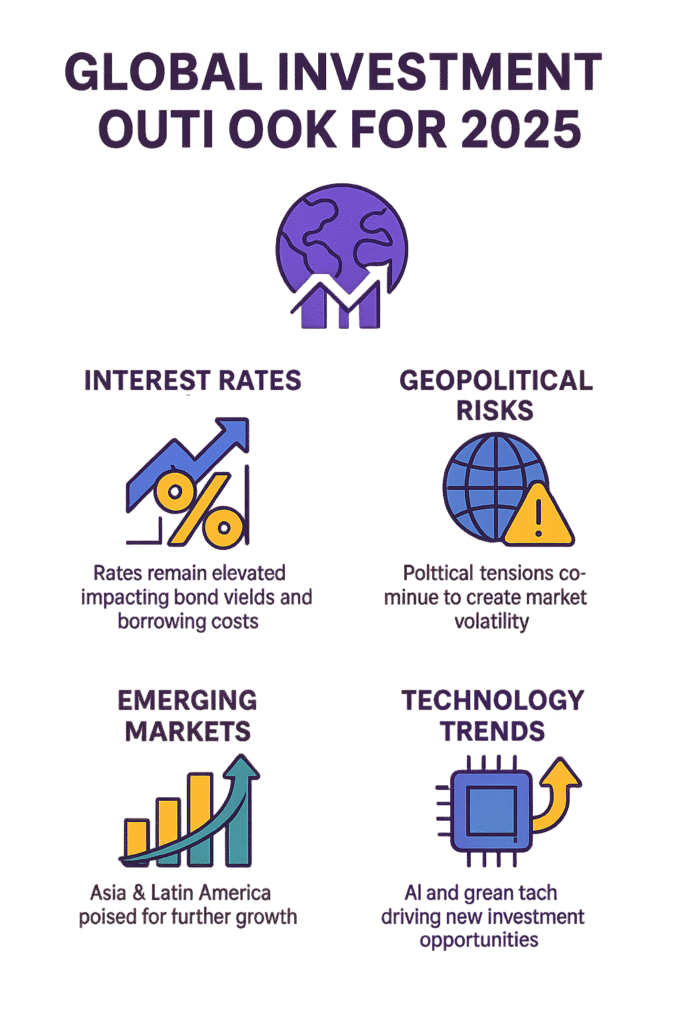Introduction: Why This Matters Now
As someone deeply invested in both markets and people—but not just numbers—every year brings its surprises. The year 2025, however, feels like a pivot point: inflation is cooling in some places, geopolitical tensions are reshaping supply chains, and AI is affecting everything from energy demand to consumer behavior.
I’ll admit: back in my early days as a banker, I focused mostly on domestic metrics—GDP, interest rates, mutual funds, SIPs. But today, my worldview is global. Why? Because as an investor—and someone helping others save for their future—I’ve learned that global forces influence Indian portfolios more than ever.
In this article, I’ll walk you through the key global investment trends of 2025, explain what they mean for you (yes, even if you only invest in domestic mutual funds), and include FAQs that address the burning questions on your mind.

1. AI-Powered Innovation: Shaping Energy, Healthcare, and Beyond
Perspective & Insight
A few weeks ago, I spoke to a client in Bengaluru about her pharma-heavy portfolio. She asked, “Why is AI suddenly showing up in my fund analysis?” The answer: AI isn’t just about tech anymore—it’s transforming healthcare (drug discovery, personalized diagnostics), energy (grid optimization, green energy forecast), and even supply chain logistics.
As businesses adopt AI, certain sectors—like healthcare, energy, and automation—are moving faster than ever. For investors, that means being open to global funds or ETFs that target firms driving AI applications, not just tech giants.
What It Means for You
Consider adding thematic or multi-cap global funds with exposure to healthcare AI or smart energy.
You don’t have to pick individual stocks—trust carefully vetted and diversified funds.
2. Geopolitics & Supply Chain Reshuffles: Think Beyond China
Perspective & Insight
Remember just a few years ago when terms like “China +10” were trending? This year, countries from Vietnam to Mexico are vying for manufacturing investment. In fact, I recently met an NRI client whose supply-chain-heavy fund allocations now include Southeast Asia and Latin America.
What It Means for You
Explore emerging market funds with diversified exposure—not just to Asia but to Latin America and Eastern Europe.
Diversification isn’t just across asset classes; it’s geographical. A factory shift in one country shouldn’t throw off your entire portfolio.
3. Green is the New Blue (Chip): ESG & Green Infrastructure Rising
Perspective & Insight
I used to think ESG was a niche concept. In 2025, it’s mainstream. Every global fund I see now includes metrics like carbon footprint, social impact, or governance indicators. India’s push for renewable energy and the global shift away from fossil fuels means growth isn’t just green—it’s also sustainable.
What It Means for You
Add a small allocation to Green or ESG funds—especially if they track global clean energy or infrastructure.
Over time, ESG isn’t just ethical—it’s profitable.
4. Rising Interest Rates & Bond Resurgences
Perspective & Insight
After years of near-zero rates, global bond yields are clawing back. It hit me when reviewing a client’s retirement portfolio last month: his debt allocation felt obsolete when a 10-year US treasury yield outperformed many domestic debt funds.
What It Means for You
You don’t need to chase bond markets globally, but consider global fixed income or bond ETFs for yield.
Especially relevant for post-retirement—higher yields mean more sustainable withdrawals.
5. Digital Assets (Still Navigating with Caution)
Perspective & Insight
We can’t talk global trends without digital assets. True, regulations are stronger, but regulated stablecoins are starting to become available—even RBI is exploring digital rupee pilots. As a CFP, I’m cautious—but curious.
What It Means for You
Don’t rush into crypto. But keep an eye on regulated stablecoins or tokenized funds as pilot options.
For now, most investors are better off in traditional equity/bond vehicles—just be aware of evolving regulations.
FAQ Section: Quick Answers to Your Burning Questions
Q1. Should I move part of my SIP into global funds?
Yes—if it fits your risk profile. A small allocation (5–10%) to global equity ETFs or funds can diversify your portfolio and hedge against domestic shocks.
2. Are global funds tax-efficient in India?
Mostly yes. Capital gains on international mutual funds are taxed similar to equity funds (10% over ₹1 lakh LTCG). Dividends get dividend distribution tax removed.
3. How do I select good global funds?
Focus on:
Fund house credibility (use fund houses like Motilal Oswal, Franklin Templeton, etc.)
Expense ratio (keep <1%)
Track record (look at 5–7 years)
Underlying holdings (are they diversified across sectors and geographies?)
4. Won’t currency fluctuations eat into returns?
Short term: yes, volatility can swing returns. Over 5–10 years, gains in strong economies usually outpace currency effects. That’s why a SIP over time smooths currency risk too.
5. Can NRIs benefit more from global funds?
Yes. NRIs often earn in foreign currencies. Having global fund exposure can align with their cash flow and provide natural hedging.
My Final Thoughts: Building a Global-Aware Portfolio
I’ve learned that geography matters in investing. Even if you invest only in Indian mutual funds, global sentiment, supply chains, and innovation shape market beats.
Here’s what I’m doing—and recommending:
Continue core SIPs in Indian equities (disciplined, tax-efficient).
Add a slice (5–15%) to a global fund or ETF with balanced exposure across sectors like healthcare, energy, tech, and infrastructure.
Use debt/bond funds with global exposure for diversification and yield.
Keep learning about ESG and digital asset shifts—but invest wisely.
Remember: global investing isn’t about guessing winners—it’s about embracing change, spreading risk, and building future-ready portfolios.





